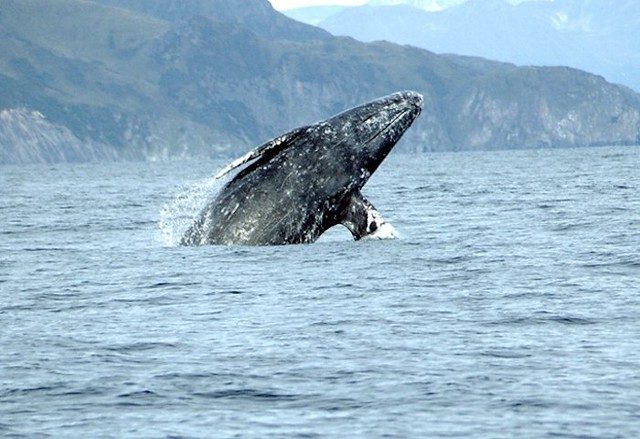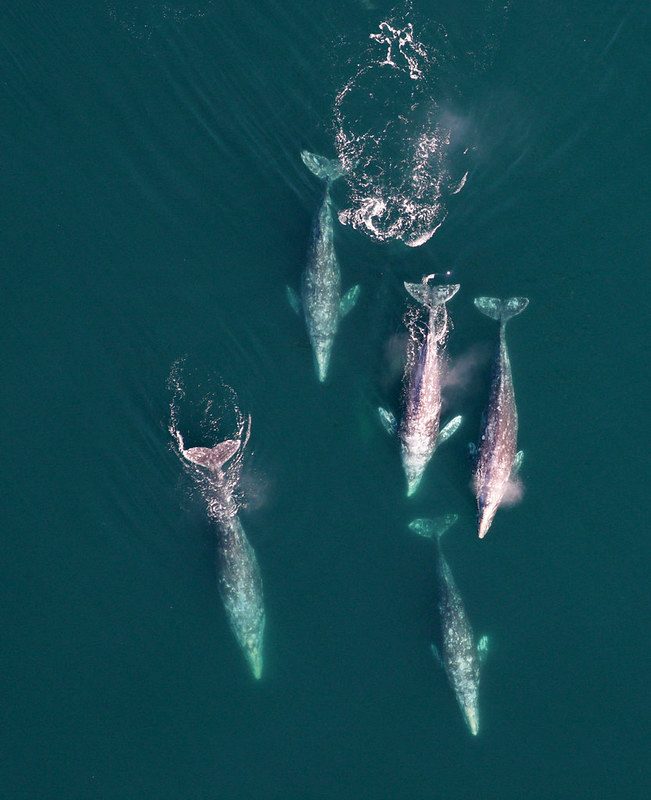Grey whales have been experiencing major population swings as a result of changing Arctic conditions – but only now have scientists worked out why the Eastern North Pacific population has been shrinking.
This population was hunted to near-extinction before the 1986 whaling moratorium and its recovery had been viewed as a conservation success story, having occurred much faster than that of most large-whale populations. It currently stands at about 14,500 whales.
The whales migrate 12,000 miles north from Mexican waters to feed in the Arctic each summer. The scientists now believe that at times when the population was growing the whales had to compete harder for shrinking resources in their feeding grounds, causing the most vulnerable to die.
US National Oceanic & Atmospheric Administration (NOAA) researchers have been monitoring the Eastern North Pacific grey whales since the 1960s, making the population the most closely studied among large whales. NOAA had declared two unusual “mortality events” among the whales in 1999 and 2019 – with the latter still continuing.

Now a team from Oregon State University’s Marine Mammal Institute (MMI) has identified a third die-off that occurred back in the 1980s, at a time before whale strandings were regularly recorded.
Each of the three events reduced the population by up to 25%, according to the MMI’s new study. After the two die-offs in the ’80s and ’90s the population had quickly rebounded, but only because on those occasions conditions in the Arctic had improved.
Initially reductions in summer sea-ice in the Arctic caused by climate change had boosted foraging opportunities for the whales. Over time, however, the biomass of their shrimp-like amphipod prey was falling. The amphipods depend on algae that fall to the seabed from the sea-ice, so they are susceptible to any reduction in the ice cover, while their habitat is also affected by the resulting faster currents.

“When the availability of their prey in the Arctic is low, and the whales cannot reach their feeding areas because of sea ice, the grey whale population experiences rapid and major shocks,” says Joshua Stewart, an assistant professor and lead author of the study.
“It turns out we didn’t really know what a healthy baleen whale population looks like when it isn’t heavily depleted by human impacts.
“Our assumption has generally been that these recovering populations would hit their environmental carrying capacities and remain more or less steady there. But what we’re seeing is much more of a bumpy ride in response to highly variable and rapidly changing ocean conditions.”

“We are in uncharted territory now,” says Stewart. “The two previous events, despite being significant and dramatic, only lasted a couple of years. The most recent mortality event has slowed and there are signs things are turning around, but the population has continued to decline.
“One reason it may be dragging on is the climate-change component, which is contributing to a long-term trend of lower-quality prey.
“I wouldn’t say there is a risk of losing grey whales due to climate change, but we need to think critically about what these changes might mean in the future. An Arctic Ocean that has warmed significantly may not be able to support 25,000 grey whales like it has in the recent past.” The findings are published in the journal Science.
Dominica plans sperm whale reserve

The Caribbean island of Dominica, where whale-watching trips have long been the deco-day pastime of choice for visiting scuba divers, has stated its intention to create the world’s first sperm whale reserve.
Vessels more than 18m long are to be restricted to a narrow corridor within a 300sq mile protected zone west of the island, and only small-scale artisanal fishing is to be allowed. Tourists will be permitted to interact with the whales in the water, but only on a limited basis.
The move was announced by Prime Minister Roosevelt Skerrit on 13 November, though the necessary legislation remains to be enacted and enforcement measures set up.
Some 35-50 families of up to 250 sperm whales are thought inhabit the area, and they tend not to travel far. Slow to reproduce, with females producing a single calf every five to seven years, the whales use the area as a feeding and nursery ground – but ship strikes and net entanglements have been threatening the population.
The move is also claimed to have a climate-change aspect because, once sperm whales return to the surface after consuming their squid prey, their large quantities of nutrient-rich faeces encourage plankton blooms. These in turn are said to trap carbon dioxide, sequestering it in the depths as the plankton dies.
Also on Divernet: Whale’s gut reveals £430k ‘treasure’ that killed it, From whale to seabird, they travel the same, Three big whale tales, Diver’s too-close whale encounter, Gliders reveal whales’ breakfast habits

